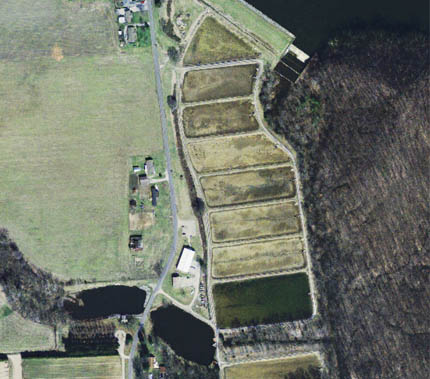Main Content
Article
Driftwood State Fish Hatchery

4931 S. CR 250 W.
Vallonia, IN 47281
812-358-4110
Get Directions
The Driftwood State Fish Hatchery, located in Vallonia, IN, in Jackson County, and constructed under the Works Projects Administration (WPA) in the late 1930's, this warm water facility consists of earthen rearing ponds and one brood-fish holding pond. The rearing ponds range from 0.6 to 2.0 acres in size and provide a total of 11.6 acres for raising fish. Maximum depth of each rearing pond is approximately 5 feet. Five, 1,000-gallon linear raceways, housed in the fish culture portion of the office/service building, provide facilities for feed training, and fish holding.
The primary fish culture responsibilities of the hatchery are the production of Largemouth bass and Channel Catfish fingerlings for stocking in Indiana’s many public waters. However, most all warm-water and cool-water species can be produced at this facility. Species raised in the past include bluegill, redear sunfish, black crappie, walleye, hybrid walleye, northern pike, and muskellunge.
Starve Hollow Lake is the sole water supply to the hatchery. Water is drawn from a depth of approximately 6.5 feet and gravity fed to the hatchery ponds. The water is passed through a 382-micron mechanical strainer to prevent contamination with lake fish, which would compete with or prey on, those being raised. Water for the inside raceways is pumped from the brood-fish holding pond and/or Starve Hollow Lake.
The hatchery is staffed by one Property Manager, one Assistant Property Manager, and the Statewide Hatchery Secretary. The District 7 Private Lands Wildlife Biologist is also headquartered at the hatchery.
The hatchery is funded entirely from the Fish & Wildlife Fund, which is comprised of monies generated from the sale of hunting, fishing, and trapping licenses. All monies spent for hatchery operation are eligible for 75% reimbursement from Federal Dingle-Johnson and Wallop-Breaux funds.
FISH CULTURE
- Largemouth Bass
Largemouth bass production begins in April. Near the end of April, as water temperature approaches 65ºF, the bass brood fish are removed from the holding pond at Cikana SFH, identified by sex, and transferred to the spawning pond(s) at Driftwood. The spawning pond(s) at Driftwood have premade nest mats made of a combination of Spawntex material and 5L river gravel. Approximately 50 pairs are stocked per acre.
The male will select a spawning site by fanning the gravel free of silt with his tail. He then guards the site until a female arrives to deposit her eggs. The eggs are pale yellow in color, about 1.5 millimeters in size (0.06 inches), and have a sticky covering which allows them to adhere to the spawning mat. Once spawning is completed, the female leaves and the male remains to care for the eggs.
At this point, hatchery staff check the nests daily for the presence of eggs. Nests that have eggs present are transferred inside the culture building and suspended vertically in the raceways. Hatching occurs 3 to 5 days after spawning. An additional 10 to 14 days are required for the fry to develop to the “swim-up” stage, at which time they will “school” in the raceways. The fry are then collected and are stocked in the production ponds at 50,000 fry per acre for Phase 1 (short) production.
Preparation of the production ponds begins when brood-fish are moved to the spawning pond. The ponds are filled, and organic fertilizers (alfalfa meal or soybean meal and /or cottonseed meal) and inorganic fertilizer (18-46-0) are applied. The fertilizer promotes phyto- plankton (minute plants) production, which in turn promotes zooplankton (tiny aquatic animals) production. The zooplankton provides forage for the bass fry during this early stage of life.
Organic and inorganic fertilizer is applied weekly to maintain maximum plankton density. The fry will remain in the nursery ponds for 25-30 days, at which time they will be approximately 2.0 inches in length.
At 2.0 inches in length, the bass require larger prey, such as aquatic insects or small fish. The bass are removed from the nursery ponds, graded to ensure size uniformity, and transferred to grow-out ponds for rearing to a fall stocking size of 4.0 inches. The number stocked is reduced to 11,000 per acre to ensure the ability of the pond to produce adequate forage is not exceeded.
- Redear Sunfish
- Channel Catfish
- Fathead Minnows
VOLUNTEER OPPORTUNITIES
Need a reason to get outside and move? You can volunteer alone or in small groups at this property. Some activities include trash pick-up, basic gardening, painting, and more. Call the property office for details.
